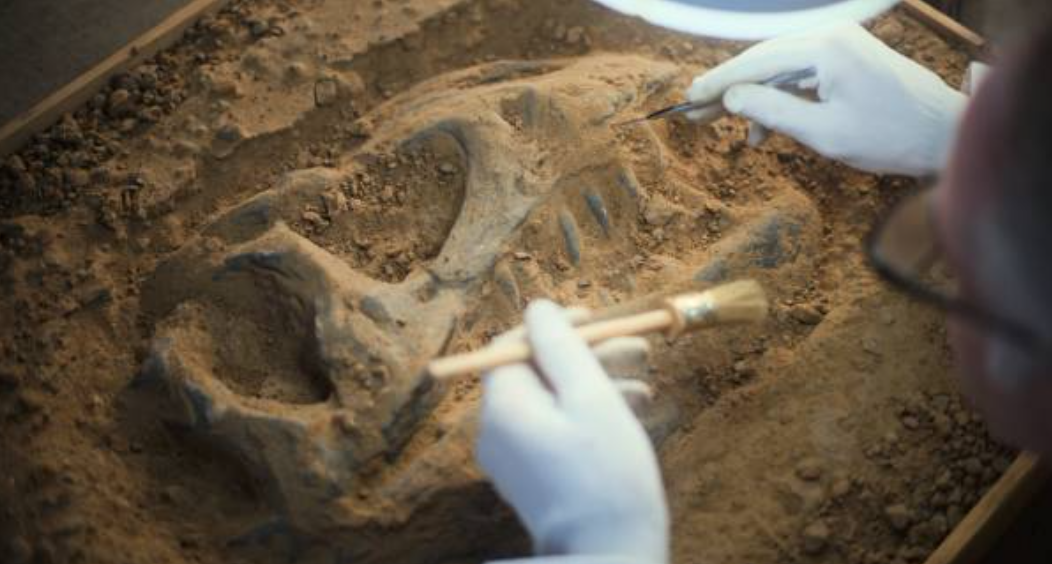When I was little, I wasn’t really passionate about dinosaurs. I did find the Parasaurolophus cool because it looked like it was wearing a ponytail, but I wasn’t able to spit out facts about them at lightning speed or do anything impressive like that. However, like many kids growing up, I found them fascinating. Fast forward about ten years, and here I am, spending my free time researching dinosaurs. Never in a million years did I see that coming. The amazing thing about Blue & Read is the creative freedom we are given when choosing our article topics. For this edition, I chose to deepen my knowledge of dinosaurs, or more broadly, paleontology. With that being said, let us begin.
During my deep dive, I came across a particularly fascinating discovery: dinosaurs, like other animals, had deadly cancer. Cancer, a disease many of us believe is modern, actually existed millions of years ago.
Discovery #1:
According to the Osteosarcoma Institute, advanced bone cancer (also known as osteosarcoma) was discovered in 2020 in the fibula, or lower leg bone, of a 77-million-year-old Centrosaurus. These horned herbivores lived about 75 to 77 million years ago, and the aforementioned fossil was originally found in 1989 in Alberta, Canada (6).
Originally, experts thought that the deformed leg bone was healing from a fracture, but advanced medical imaging and further analysis proved them wrong and ultimately led to the first confirmed case of malignant cancer in a dinosaur at the cellular level. According to NIH, “Malignant cells grow in an uncontrolled way and can invade nearby tissues and spread to other parts of the body through the blood and lymph system.” Don’t worry, though. The dinosaur did not die from the cancer, but it is rather believed to have died due to a flood (2).
Experts discovered the cancer using tools such as high-resolution computed tomography (CT) scans and comparative pathology. CT scans are now more commonly used to produce detailed 3D visualizations of internal structures without destroying what’s being studied (3). Comparative pathology of fossils involves identifying signs of disease and comparing the results to the living species today (4). Essentially, they took CT scans of the diseased fossil and compared them with a more recent bone with the same disease pathology.
This finding has shown that even ancient creatures suffered from complex diseases that are similar to those found in humans today.
Discovery #2:
While bone cancer in the Centrosaurus provides new insights into how cancer can be detected in hard tissue, researchers have also made remarkable progress analyzing soft tissue in other dinosaur fossils. Recently, experts have used high-powered microscopy – a tool capable of detecting incredibly small biological structures – to discover structures that look like red blood cells (or erythrocytes) in the fossilized remains of a Telmatosaurus Transsylvanicus dinosaur, “a small, cow-sized ‘marsh lizard.’” It lived around 66 to 70 million years ago in what we now call Romania (5).
Interestingly, these preserved soft-tissue structures point to a tumor previously identified on the fossilized jawbone of the same dinosaur. This proves that not only did the species suffer from tumors, but also that traces of these diseases can survive at the molecular level for millions of years. Since soft tissue contains proteins with molecular information, this discovery could reveal how diseases developed at a molecular level. Additionally, this discovery challenges previous beliefs, suggesting that small flecks of soft tissue may be preserved in fossils more often than researchers believed. In the future, this will allow for more detailed analysis of ancient diseases in the fossil record.
So, why are discoveries like these so important, and how could they impact our future?
The first discovery underlines the importance of re-evaluating fossils with new technology to make connections between current human diseases and ancient diseases (2). The second discovery illustrates how research like this enables new methods and further exploration that may lead to future breakthroughs (5). Furthermore, according to NIH, studying ancient proteins in fossils could potentially allow us to learn more about the molecular markers of disease in ancient species (1).
These groundbreaking discoveries of advanced bone cancer in a Centrosaurus and tumor evidence in a Telmatosaurus reveal that diseases like cancer have deep evolutionary history. This offers a new perspective on the biological past of creatures that inhabited this planet millions of years ago, and it can pave the way for major medical breakthroughs.
Works Cited
- Chandrasinghe, Pramodh Chitral, et al. “Preserving Fossilized Soft Tissues: Advancing Proteomics and Unveiling the Evolutionary History of Cancer in Dinosaurs.” Biology, U.S. National Library of Medicine, 3 Apr. 2025, pmc.ncbi.nlm.nih.gov/articles/PMC12025216/#:~:text=Simple%20Summary,of%20disease%20in%20ancient%20species.
- “Dinosaur Diagnosed with Cancer for the First Time.” YouTube, YouTube, www.youtube.com/watch?v=Uk8PB1LGeuk. Accessed 27 Sept. 2025.
- Dumbravă, Mihai D., et al. “A Dinosaurian Facial Deformity and the First Occurrence of Ameloblastoma in the Fossil Record.” Nature News, Nature Publishing Group, 5 July 2016, www.nature.com/articles/srep29271.
- Garcês, Andreia, et al. “Ancient Diseases in Vertebrates: Tumours through the Ages.” Animals : An Open Access Journal from MDPI, U.S. National Library of Medicine, 15 May 2024, pmc.ncbi.nlm.nih.gov/articles/PMC11117314/.
- Nield, David. “Scientists Found Cancer in a Dinosaur – and It Might Help Save Human Lives.” ScienceAlert, 13 June 2025, www.sciencealert.com/scientists-found-cancer-in-a-dinosaur-and-it-might-help-save-human-lives.
- Osi. “Osteosarcoma Discovered in a 77-Million-Year-Old Dinosaur Bone.” Osteosarcoma Institute, 3 Mar. 2022, osinst.org/blog/osteosarcoma-dinosaur-bone/.

